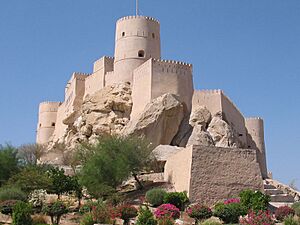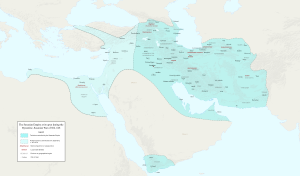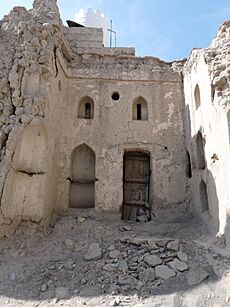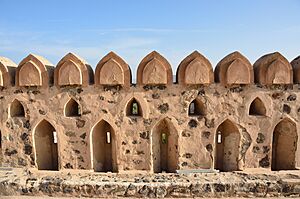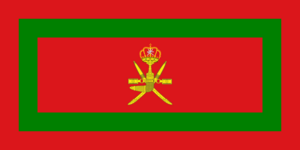History of Oman facts for kids
Oman is a country with a very long history, where people have lived for over 100,000 years! Many powerful groups have influenced the region, including other Arab tribes, Portugal, and Britain. At its strongest, Oman controlled lands stretching from the Persian Gulf all the way south to the island of Madagascar. This included important places like the island of Zanzibar, the city of Mogadishu, and the city of Gwadar.
Contents
Ancient Times: Early Humans in Oman
In 2011, scientists found over 100 places in Oman with stone tools from a time called the late Nubian Complex. These tools were thought to be only from Sudan before this discovery. Tests show these tools are about 106,000 years old. This proves that a special type of stone tool-making existed in southern Arabia a very long time ago.
Scientists believe that early humans left Africa to explore the rest of the world by crossing the Bab el Mandab strait in the southern Red Sea. They then moved along the green coastlines around Arabia and into other parts of Asia and Europe. This journey was possible when sea levels dropped by more than 80 meters, uncovering land between Eritrea and Yemen. This happened during a cold period about 60,000 to 70,000 years ago.
Between 135,000 and 90,000 years ago, tropical Africa had very big droughts. These droughts forced humans to move from the dry land towards the sea. This pushed them to cross to other continents. Scientists studied pollen from lake mud in Africa to understand the plants that grew there over time. Samples from the drought periods showed very little pollen, meaning few plants grew, and the area was like a desert.
Another way scientists learn about the past is through a method called luminescence dating. This technique measures natural radiation stored in sand. Data from this method shows that 130,000 years ago, the Arabian Peninsula was warmer and received more rainfall. This turned it into a lush, green land where people could live. During this time, the Red Sea was also very shallow, only about 4 kilometers (2.5 miles) wide. This gave humans a short chance to easily cross the sea and travel across the green Arabian Peninsula. These early travelers, escaping climate change in Africa, crossed the Red Sea into Yemen and Oman. They walked across Arabia when the climate was good.
Archaeologists have found Paleolithic stone tools in caves in southern and central Oman, and in the United Arab Emirates near the Strait of Hormuz. Some of these tools are up to 125,000 years old and look similar to tools made by humans in Africa around the same time.
Persian Influence
The northern part of Oman was likely a region of the Persian Achaemenid Empire. This was a very large empire in ancient times. Later, from about 100 BCE to 300 CE, groups of people speaking Semitic languages moved into central Oman.
The Kingdom of Oman was later taken over by the Sasanian Empire's army. The Sasanian army had 4,000 soldiers stationed in a place called Jamsetjerd (now known as Jebel Gharabeh).
Becoming an Islamic Nation
Oman learned about Islam in 630 CE, while the Prophet Muhammad was still alive. The religion became firmly established in Oman during the Ridda Wars in 632 CE.
In 751 CE, a group of Muslims called the Ibadi Muslims started an imamate in Oman. An imamate is a state led by an Imam, who is a religious and political leader. The Ibadi imamate continued, with some breaks, until the mid-20th century.
Today, Oman is the only country where most of the people are Ibadi Muslims. Ibadism is known for being "moderately conservative." A special thing about Ibadism is that the ruler is chosen by the community's agreement and approval. The Imam's position was confirmed when he gained the loyalty of the tribal leaders and received an oath of allegiance from the public.
Outside Powers and Oman's Rise
Many foreign powers attacked Oman over the centuries. The Qarmatians controlled the area for short periods in the 930s. Between 967 and 1053, Oman was part of the Iranian Buyyid empire. Then, from 1053 to 1154, it was part of the Seljuk Empire.
In 1154, the local Nabhani dynasty took control of Oman. The Nabhani kings ruled until 1470, with a break between 1406 and 1443.
The Portuguese took control of Muscat on April 1, 1515, and held it until January 26, 1650. The Ottoman Empire also controlled Muscat for short periods in the 1550s and 1580s. Around 1600, the Nabhani rule was briefly restored, but only until 1624. That's when the fifth imamate, known as the Yarubid Imamate, began. This new imamate recaptured Muscat from the Portuguese in 1650, ending their control that had started in 1508.
The Omani Yarubid dynasty then became a powerful force itself. They took over former Portuguese colonies in East Africa and became involved in the Indian Ocean slave trade. Their power was centered on the Swahili coast and the island of Zanzibar.
By 1719, a new ruler, Saif bin Sultan II, was chosen. But this led to a civil war between two major tribal groups, the Hinawi and the Ghafiri. In 1743, the Persian ruler Nader Shah took over Muscat and Sohar with Saif's help. Saif died, and another ruler, Bal'arab bin Himyar, took his place.
This Persian involvement caused a revolt. The leader of the revolt, Ahmad bin Said al-Busaidi, took advantage of the Persian king's death in 1747. He drove out the Persian forces and defeated Bal'arab. Ahmad bin Said was then chosen as the sultan of Muscat and imam of Oman.
The Al Busaid family then became the royal dynasty of Oman. Like earlier ruling families, the Al Busaid dynasty had its share of family disagreements and power struggles. There were also frequent challenges from the independent tribes in the interior of the country. The Al Busaid rulers later gave up the title of Imam. The interior tribes, however, still saw the Imam as the only true ruler and fought to bring back the imamate.
The ruling family split into two main groups before Ahmad ibn Said's death in 1783:
- One group, led by Sultan ibn Ahmad, controlled the coastal areas and officially the whole country.
- Another group, the Qais branch, had power over the Al Batinah and Ar Rustaq areas.
During the rule of Sultan Said ibn Sultan (1806–1856), Oman expanded its overseas colonies. It made money from the slave trade. As a major trading power in the 1800s, Oman controlled Zanzibar, parts of the East African coast like Mombasa and Dar es Salaam, and Gwadar (in modern-day Pakistan) until 1958.
When Great Britain banned slavery in the mid-1800s, Oman's economy suffered greatly. Many Omani families moved to Zanzibar. The population of Muscat dropped from 55,000 to 8,000 between the 1850s and 1870s. Britain took over most of Oman's overseas lands, and by 1900, Oman was a very different country.
Late 1800s and Early 1900s
When Sultan Sa'id bin Sultan Al-Busaid died in 1856, his sons argued over who would rule next. Because of this, the empire was divided in 1861, with Britain's help, into two separate areas: the Sultanate of Zanzibar and the area called "Muscat and Oman." This name was changed to "Sultanate of Oman" in 1970. This division showed two different ways of life:
- The coastal tradition: More open to the world and less religious, found in Muscat and nearby areas ruled by the sultan.
- The interior tradition: More isolated, tribal, and very religious, found in "Oman proper" ruled by an imam.
Muscat, being more connected to the world, became the stronger political culture since the Al Busaid dynasty started in 1744. However, the Imam's rule in the interior sometimes returned.
After Sa'id bin Sultan's death in 1856, his sons continued to rule separately: one in Muscat and Oman, and the other in Zanzibar. In 1868, Azzan bin Qais Al-Busaid declared himself Imam. Even though many tribes supported him, the public did not officially elect him.
Imam Azzan wanted to unite the country under a strong central government. But the British worried about his plans, thinking he was trying to change their system. The British supported Turki bin Said Al-Busaid, Azzan's rival. Turki bin Said defeated Azzan's forces, and Azzan was killed in battle in January 1871.
Muscat and Oman was a place of competition between France and Britain in the 1700s. In the 1800s, Muscat and Oman signed several trade agreements with Britain, which mostly helped the British. In 1908, the British made another agreement to control the area. Their long-standing relationship was confirmed in 1951 with a new trade and shipping treaty. In this treaty, Britain recognized the Sultanate of Muscat and Oman as an independent state, but still kept an eye on it because of its oil and strategic importance.
During the late 1800s and early 1900s, there were disagreements between the sultan in Muscat and the Ibadi Imam in Nizwa. This conflict was temporarily settled by the Treaty of Seeb. This treaty gave the Imam rule over the interior Imamate of Oman, while recognizing the sultan's power in Muscat and its surrounding areas.
Late 1900s: Modern Oman Emerges
In 1954, the conflict started again. The Treaty of Seeb was broken by the sultan after oil was found in the Imam's lands. The new Imam, Ghalib bin Ali, led a five-year rebellion against the sultan. The sultan received help from British forces and the Shah of Iran. In the early 1960s, the Imam, who was living in Saudi Arabia, got support from his hosts and other Arab governments, but this support ended in the 1980s. The Imam's case was even discussed at the United Nations, but no major actions were taken.
Zanzibar paid money to Muscat and Oman every year until it became independent in early 1964.
In 1964, a rebellion began in the Dhofar province. Rebels, supported by Communist and leftist governments like South Yemen, formed the Dhofar Liberation Front. This group later joined with a Marxist group called the Popular Front for the Liberation of Oman and the Arabian Gulf (PFLOAG). Their goal was to overthrow all traditional governments in the Persian Gulf. In mid-1974, the Omani part of the PFLOAG changed its name to the Popular Front for the Liberation of Oman (PFLO) and continued the Dhofar Rebellion.
1970s: A New Leader
In 1970, Qaboos bin Said al Said took power from his father, Said bin Taimur, who later died in London. Sultan Qaboos ruled Oman until his death. The new sultan faced a country with widespread sickness, many people who couldn't read, and poverty. One of his first actions was to remove many of his father's strict rules, which had caused thousands of Omanis to leave the country. He also offered forgiveness to those who had opposed the previous government, and many returned to Oman. In 1970, slavery was also ended in Oman.
Sultan Qaboos also created a modern government and started a big plan to improve education and health. He built modern roads and buildings and developed the country's natural resources.
To stop the Dhofar rebellion, Sultan Qaboos made the armed forces stronger and gave forgiveness to rebels who surrendered. He also fought hard in Dhofar. He received direct military help from the UK, Iran, and Jordan. By early 1975, the small groups of fighters were pushed into a small area near the Yemeni border and were soon defeated. As the war ended, community improvement projects were given priority in Dhofar, which helped gain the loyalty of the people. The threat from the PFLO lessened even more when South Yemen and Oman started diplomatic relations in October 1983.
Throughout his rule, Sultan Qaboos tried to balance the interests of different tribes, regions, and ethnic groups in his government. The Council of Ministers, which acts like a cabinet, had 26 ministers, all chosen directly by Qaboos. The Majlis Al-Shura (Consultative Council) reviewed laws about economic development and social services before they became official.
1990s: Steps Towards a Modern State
In November 1996, Sultan Qaboos gave his people the "Basic Statutes of the State," which was Oman's first written "constitution." It protects various rights based on Qur'anic and traditional law. It also brought back rules to prevent conflicts of interest, for example, by stopping cabinet ministers from being officers in public companies. Most importantly, the Basic Statutes set rules for how Sultan Qaboos's successor would be chosen.
Oman has an important location on the Strait of Hormuz, at the entrance to the Persian Gulf, directly across from Iran. Oman cares about stability and security in the region, especially with tensions nearby and the potential threat of political Islam. Oman kept its diplomatic relations with Iraq during the Gulf War. It also supported the United Nations allies by sending troops and allowing weapons and supplies to be stored in Oman.
2000s: Recent History
In September 2000, about 100,000 Omani men and women voted for 83 candidates, including two women, to be part of the Majlis Al-Shura. In December 2000, Sultan Qaboos appointed the 48 members of the Majlis Al Dowla, or State Council, which included five women. This council acts as the upper house in Oman's two-chamber government.
Sultan Qaboos's big modernization plan opened the country to the outside world. Oman has kept its long-standing political and military relationships with the United Kingdom, the United States, and other countries. Oman's balanced and independent foreign policy has aimed to maintain good relations with all Middle Eastern countries.
Sultan Qaboos, who was the longest-serving ruler in the Arab world, died on January 10, 2020, after almost 50 years in power. On January 11, 2020, his cousin Haitham bin Tariq became Oman's new sultan.
Rulers of Oman
- Said bin Sultan (November 20, 1804 – June 4, 1856) – (Sultan of Zanzibar and Oman)
- Thuwaini bin Said (October 19, 1856 – February 11, 1866)
- Salim bin Thuwaini (February 11, 1866 – October 1868)
- Azzan bin Qais (October 1868 – January 30, 1871)
- Turki bin Said (January 30, 1871 – June 4, 1888)
- Faisal bin Turki (June 4, 1888 – October 15, 1913)
- Taimur bin Feisal (October 15, 1913 – February 10, 1932)
- Said bin Taimur (February 10, 1932 – July 23, 1970)
- Qaboos bin Said (July 23, 1970 – January 10, 2020)
- Haitham bin Tariq (January 11, 2020 – present)
See also
 In Spanish: Historia de Omán para niños
In Spanish: Historia de Omán para niños
- History of Asia
- History of the Middle East
- History of the United Arab Emirates, which shares some areas with Oman
- History of the Middle East
- Economy of Oman
- Tourism in Oman
- Health in Oman
- Portuguese Oman


